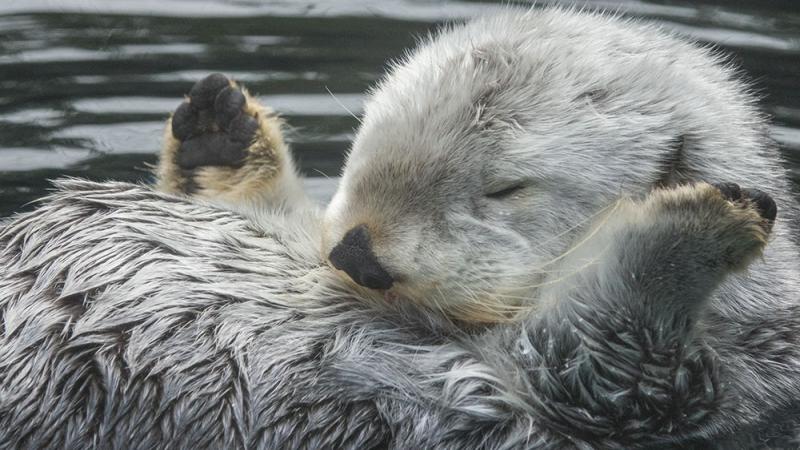Eddie the slam-dunking sea otters turns 20

Blazers present geriatric otter with enrichment toys and a new logo for his backboard
Eddie, the Oregon Zoo's ultra-geriatric sea otter, turned 20 today, but keepers and basketball experts agree: He can still dunk with the best of them and might even have the highest shooting percentage in town.
"Male sea otters seldom live past 15 years, so Eddie's among the oldest of his kind," said Nicole Nicassio-Hiskey, the zoo's senior marine life keeper. "He still loves to play hoops though, and he's definitely still got game."
Animal-care staff trained the aging otter to dunk a toy basketball as therapy for his arthritic elbow joints in 2012. A video about his behind-the-scenes exercise routine went viral the following year, clocking more than 1.7 million views on the zoo's YouTube channel, and making him one of the most famous animals on the Internet.
For a sea otter, 20 years is considered extremely old, and Eddie's fur — once a rich brown over his entire body — has turned creamy white around his face, neck and belly.
To mark his milestone birthday this morning — and pay homage to the marine mammal's exceptional dunking skills — Portland Trail Blazers mascot, Blaze, delivered a gift basket full of enrichment toys to Eddie's keepers and affixed a brand-new Blazers logo on the backboard at his behind-the-scenes training area, a small pool connected to the zoo's Steller Cove habitat via underwater tunnel.
Eddie's keepers think Blazers coach Terry Stotts — who majored in zoology at the University of Oklahoma — might appreciate Eddie both for his hoop skills and his ability to inspire sea otter conservation. Considered a keystone species, sea otters play a critical role in the Pacific Coast marine ecosystem, promoting healthy kelp forests, which in turn support thousands of organisms and reduce CO2 levels in the atmosphere.
Eddie has lived at the Oregon Zoo since 2000, on long-term loan from the U.S. Fish and Wildlife Service. He was rescued along the coast of California, where he was abandoned as a pup in 1998. Lacking the skills to survive on his own in the wild, he was taken to the Monterey Bay Aquarium's Sea Otter Research and Conservation program for rehabilitation but eventually deemed non-releasable by USFWS.
In 2012, Eddie was included in an Oregonian article about elderly Oregon Zoo inhabitants highlighting the ways keepers and veterinary staff care for animals approaching the end of life.
Sea otters — listed as threatened on the Endangered Species list — once ranged along the north Pacific Rim from Japan to Baja California, including along the Oregon coast, and are thought to have numbered between 150,000 to 300,000 animals. Prized for their fur, the animals were hunted to the brink of extinction during the late 1800s and early 1900s. By 1911, aggressive fur-trapping campaigns had reduced the global sea otter population to around 2,000.
Although now protected against trapping, sea otters are threatened by oil spills, fishing nets and infectious diseases. Biologists estimate the population has dropped by 50 percent over the past 30 years. Wild sea otters have not established colonies off the Oregon coast since 1907.
More News

Rescued cougar cubs are venturing out
A pair of orphaned cougar cubs, rescued and brought to the zoo by Washington Department of Fish and Wildlife staff in November, have begun exploring their outdoor habitat.April 17, 2025

Zoo seeks pika watchers for summer season
The Oregon Zoo is recruiting volunteers for Cascades Pika Watch.April 15, 2025

Zoo convenes action for imperiled elephants
Sabah government representatives joined conservation NGOs, local communities, palm oil producers, and tourism operators this week in the fight to save the world’s smallest elephants from extinction.April 11, 2025

